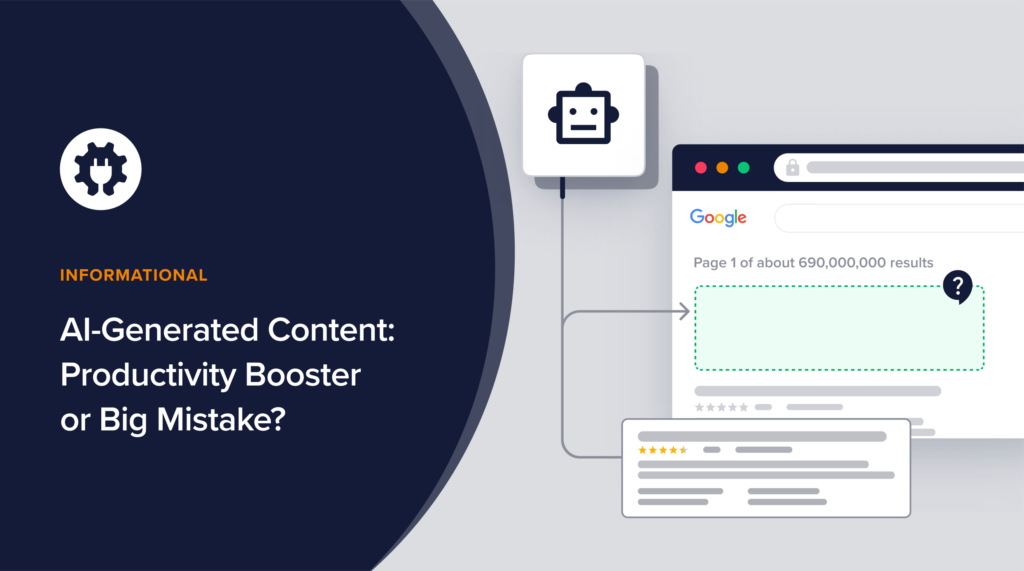Thinking about using AI-generated content for blog posts?
Some people claim you can use AI chatbots to write articles that rank high in search results. Is that true? Can AI-generated content deliver SEO success?
In this article, we’ll sort the fiction from the facts. We’ll explain what AI-generated content is, when it makes sense, and when it might be a time-sink.
In This Article
- What’s the Appeal of AI-Generated Content?
- What is AI-Generated Content?
- How Do You Get AI-Generated Content?
- SEO and AI-Generated Content
- Test-Driving Tools for AI-Generated Content
- Optimizing Content for SEO
- Best Uses for AI-Generated Content
- List of AI Content Generator Tools
- Cons of AI-Generated Blog Posts
What’s the Appeal of AI-Generated Content?
AI content tools are pitched as saving time and money. They’re also marketed as ways to brainstorm and break writer’s block.
Everyone likes a good shortcut, so why not farm out work to machines? What’s not to like about instant, push-button articles?
To arrive at an answer, let’s start by sorting out exactly what we mean by AI-generated content.
What is AI-Generated Content?
AI-generated content is textual, video, audio, or image content created by a Large Language Model (LLM) in response to user input.
And what’s an LLM? Let’s ask Google’s Generative AI.
“A large language model (LLM) is a type of artificial intelligence (AI) algorithm that uses deep learning techniques and massively large data sets to understand, summarize, generate and predict new content.”
Large language models use their predictive power when creating content to decide which sentence should follow the previous one.
Examples of large language models include OpenAI’s GPT-3 and GPT-4, Meta’s LLaMA, and Google’s PaLM 2
Next, let’s look at where AI content is being used.
AI Content is Everywhere
AI content doesn’t just show up in blogs. It’s everywhere, from social media feeds to videos, images, and news.
For instance, AI-generated content is used for
- Virtual beings that inhabit interactive stories.
- Summaries of customer sentiment.
- Product and hotel descriptions.
This article focuses on using AI to create blog posts.
We’ll also look at:
- How news media and corporations use AI-generated content.
- How you can use AI to improve your content creation workflow.
First, let’s find out how people get AI-generated content.
How Do You Get AI-Generated Content?
You can get AI-generated content for free from ChatGPT or Bard. Or you can use software services that charge monthly fees.
The main difference between these 2 options is the interface.
- With ChatGPT or Bard, you’ll enter a “prompt” (a text request for what you want).
- With the software products, you’ll enter information into their form fields. For example, there might be 1 field to add a topic to and another for keywords.
The best-known AI content generators targeting consumers use the same technology as ChatGPT. Examples are Jasper and Copysmith.
And some of these generators are bundled with multiple AI tools.

ChatGPT and Bard
The release of OpenAI’s ChatGPT and Google’s Bard made it possible to click a button and get instant articles for free.
Type in your request, and you’ll get a fluent article with no grammatical errors.
ChatGPT and Bard are large language models (LLMs) which use natural language processing (NLP) technology.
This has led to an explosion of social media threads offering playbooks for making money with AI-generated blog posts and videos.
These influencers claim your AI content will rank high in search engine results. So why bother writing it yourself?
But if everyone, even your pet parrot, can create push-button content, why would the marketplace value it?
After all, one of the key drivers of value is scarcity. And you know what there’s a scarcity of?
Original insights and compelling content forged from personal experience.
SEO and AI-Generated Content
Insights and experience are aspects of quality content. And quality is the most important SEO ranking factor.
Since Google has defined quality content, it’s worth reviewing their guidance. And don’t forget Google’s emphasis on E-E-A-T (Experience, Expertise, Authority, Trustworthiness).
Keeping these things in mind, let’s note what AI can’t do:
- Bring real-world experience, whether from one’s personal life or career, to bear on topics.
- Provide original insights or divergent thinking on a topic.
- Create original analyses.
- Provide a real author’s byline and bio.
- Synthesize information in a way that delivers high value.
- Produce quality narrative non-fiction.
- Create content thought leadership.
- Provide in-person eyewitness accounts.
- Decide how to create an article that is more comprehensive, insightful, or useful than existing articles.
It sounds counterintuitive, but writing for people rather than search engines is the way to win at SEO.
This is because search engines, including Google, are engineered to satisfy search intent. That means they reward content based on how helpful, informative, or valuable it is to searchers.
Keyword Research and Search Intent
Although missed by many users, Google and other search engines provide valuable data for planning your content.
If you’re new to the concept of search intent, explore this example.
Given that high-quality content starts with doing keyword research and understanding search intent, it’s difficult to see how AI-generated content can meet the mark.
Indeed, ChatGPT, unlike Google, isn’t designed to understand, display, or satisfy search intent.
And as we noted, AI content has no author or real-world experience or expertise, factors that are central to Google’s E-E-A-T guidelines.
And even AI tools that support content creation but don’t generate it require a knowledgeable human to make sound decisions about AI-based recommendations.
To skip over this decision-making process is to create content for search engines rather than people.
And that’s not good for SEO.
Now let’s test-drive some AI content generators.
Test-Driving Tools for AI-Generated Content
Most AI content generators offer form fields to type keywords or other instructions into.
In the example below, we provided a title and some keywords.

Then the AI tool generated an outline.
Here’s an example of a subheading in the outline with AI-generated “talking points” underneath.

The subheadings and talking points were disappointing.
So we ditched the outline and wrote our own. Then we clicked the “Regenerate Talking Points.”
Here’s a subheading from our hand-written outline. These talking points were equally vague.

Notice the highlighted talking points above. They contradict one another.
Well, that was underwhelming.
We tested two other platforms and found the results were unusable.
- We gave a platform specializing in generating blog posts a simple test: explain what Undraw.co is. We also provided keywords as clues. We got an unusable article filled with errors.
- We tried a 3rd platform to generate FAQs. These were unimpressive. None of them were optimized for SEO.
That doesn’t mean there aren’t some excellent uses for AI in content. It means that AI doesn’t “think” or “understand.” It generates permutations of plausible-sounding phrases based on predictions about what should come next.
That said, not all AI content apps are created equal.
Some, like Writer.com, offer ways to streamline your workflow by importing style guides and by training the AI on your brand voice.
And some, like Automated Insight’s WordSmith, are in a different category altogether.
To understand more, let’s look at:
- How AI-generated content is used in news media and corporations.
- Situations where AI supports content creation without actually generating it.
Use of AI-Generated Content in News and Business
Did you know that AI generates millions of news, corporate, and marketing content items monthly?
For example, the Associated Press has long used artificial intelligence to produce routine stories on corporate earnings and sports scores. This has enabled them to relieve reporters of mundane tasks and put them on higher-priority assignments.
Like Yahoo! Sports, the Orlando Magic, and other companies, the Associated Press uses Automated Insights’ Wordsmith. This software uses natural language generation (NLG) to turn data input into reports and narratives.
Accurate Data
Wordsmith users provide their own data. So, this process differs considerably from giving a prompt to ChatGPT or to a consumer-level AI content generator.
These datasets might be proprietary or from 3rd party providers like commodity exchanges or APIs that deliver live sports scores.
By contrast, ChatGPT, Bard, and apps that use them can generate false statements, a phenomenon called hallucination.
Wordsmith created the sole API for natural language generation (NLG).
Reports and Narratives
In Wordsmith, users control the type of report or narrative generated. Once a content template is created, placeholder variables are replaced with actual data.
Wordsmith can update data in a story in real-time. And it provides ways to vary the text by using conditional logic, which it calls “branches.”

Current e-commerce and news use cases include
- Hotel descriptions
- Product descriptions and listings
- In-app and email messaging
- Fantasy football draft reports
- Text displayed in corporate dashboards
- Local election coverage (Switzerland)

AI Tools for Planning Content
AI tools are also widely used in planning and marketing content too. In these cases, they may automate functions, provide insights for ranking higher, or make suggestions for improving content.
- Grammarly is a well-known app for checking grammar, tone, and clarity
- Clearscope and MarketMuse use machine learning to collate search data so teams can prioritize and create the right content more efficiently.
- samdesk scans the web, including social media, to alert its users to unfolding events that could impact their operations. Journalists are among those who use this early warning system to identify and cover breaking news events.

Optimizing Content for SEO
Once you’ve created your content, you can optimize it for search engines using All in One SEO (AIOSEO).
This is an established plugin with thousands of 5-star reviews on WordPress.org. Currently, over 3 million sites are using it.

Designed for ease of use, All in One SEO analyzes your content and provides specific steps to improve it so it ranks higher.

We use All in One SEO (AIOSEO) on every article before we publish it. And it plays a big part in growing our revenue and sales.
It takes us about 5 minutes to work through the recommendations and push our SEO score up.
The plugin also includes readability recommendations. And it provides a click-button way to turn your web pages into rich snippets.

ChatGPT Integration
This year All in One SEO (AIOSEO) released a ChatGPT integration that allows you to use it to generate titles and meta descriptions inside WordPress.
To use it you’ll simply click on the robot icon next to the title or description field.

Then you can generate 5 titles or descriptions at a time.
See the SEO Impact of Your Changes
AIOSEO is unique because it shows you how your edits impact your search engine rankings.
This new feature is called SEO Revisions. And All in One SEO (AIOSEO) is the only plugin that offers it.
You’ll also see when Google releases new algorithm updates and how those impact your content.

Best Uses for AI-Generated Content
While it’s a mistake to hand over your content strategy to AI, artificial intelligence can help you attain your goals.
We encourage you to experiment with AI to discover what works for you.
Skip using consumer-level AI apps to generate long-form articles. Instead, experiment with AI-generated text for:
- Ad copy
- Emails
- Press releases
- Rote reporting
- Social media posts
- Product descriptions.
When you use AI to generate copy, you can scavenge the results for ideas. Or take several versions and combine them into one.
And if you do try AI for generating short blog posts, we recommend using ChatGPT and giving it a specific prompt. It can produce quality listsicles, for example. But remember, the chatbot doesn’t take into account search intent, which is crucial for ranking.
How Are We Using AI?
Here at AIOSEO we’re experimenting daily with AI to bring you results you can use. And there are some AI tools we use regularly.
Not surprisingly, we use All in One SEO (AIOSEO) for SEO. It includes AI-powered tools like Link Assistant.
We also use Clearscope to assist in planning and creating content.
We’re experimenting with ChatGPT for email copy. Here it’s worth noting that you can A/B test AI-generated email against human-generated email. Then let your audience decide which is more click-worthy.
If you have a ChatGPT Plus account, take the Copywriter plugin for a spin. We’ve found it to be a useful tool for livening up marketing copy.
List of AI Content Generator Tools
Here are some well-known tools for content creators who want to experiment with AI. Some of these come with multiple AI tools, not just content generators.
Pricing for these apps ranges from free (for limited versions) to negotiation-based pricing for enterprise use.
Many offer webinars and video courses on how to use their tools
Cons of AI-Generated Blog Posts
Now, let’s review the cons of using chatbots or consumer-level AI apps to generate long-form articles.
Wasted Time
Mediocre outlines, lack of search engine optimization, and factual errors can cause content production to take more time rather than less.
When considering AI tools, it’s best to start by identifying the problem you’re trying to solve. Too often, AI tools are shiny objects that appear as solutions to problems we don’t have.
Plagiarism
Some researchers claim to have found evidence that AI language models “display plagiarizing behavior.”
While the plagiarism detection methods used by these researchers could theoretically be deployed as filters within future iterations of LLMs, it’s wise to be aware of the risks.
Plagiarism carries liability costs, high enough to shut a small business down. In the United States, plagiarism fines can be as high as $250,000 per instance.
Some AI content generators like Surfer include a plagiarism checker.
Poor SEO
AI software can’t replace sound SEO decisions made by human writers.
At its annual Google I/O conference, the search giant announced that helpful content system changes are coming.
These algorithm changes will include a “greater focus on content with unique expertise and experience.”
If your content doesn’t demonstrate first-hand experience or original insights, it risks being demoted.
Bonus Tips
Looking for more ideas for creating original content that ranks?
Explore these resources.
- Learn how to create long-form content that ranks
- Plan to capture leads.
- Get inspired with 103 content ideas.
- Check out the 8 best digital marketing practices.
- Learn how to make money with paid content writing.
- Get content writers for your blog.
- Explore using AI content writing in WordPress.
Q&A on AI-Generated Content
What is generative AI?
Generative AI is AI that produces text, images, calculations, or video in response to prompts. ChatGPT, Bard, StableLM 7B, Claude, Command, and JinaChat produce textual, numerical, or code answers. And Midjourney, Lexica, Stable Diffusion, and DALL-E produce images.
Will Google penalize AI content?
Google rewards quality content that evidences personal experience, expertise, authoritativeness, and trustworthiness. These qualities are captured in Google’s E-E-A-T standards. AI content generators, marketed to consumers, cannot offer personal experience or individual expertise. That said, some specialized uses of AI, characterized by data integrity, would likely not be penalized. Read more about Google’s stance on AI.
What’s Next?
So, will content creators wind up like George Jetson, working 2 hours a day pushing buttons? So far, it seems unlikely.
Consumer apps that promise the ability to generate high-quality blog posts appear over-hyped. But intelligent use of AI can boost productivity and results. And the use of AI to conversationally query data is going to be a game changer.
We hope this article helped you understand AI-generated content and the risks to SEO when using it.
What’s next? Explore AIl in One SEO’s AI-powered features and check out our round-up of the best on-page SEO tools. You may also find these AI-based SEO tools interesting.
If you found this article helpful, subscribe to our YouTube Channel. You’ll find plenty of beginner-friendly WordPress tutorials there. You can also follow us on Twitter, LinkedIn, or Facebook to stay in the loop.
Disclosure: Our content is reader-supported. This means if you click on some of our links, then we may earn a commission. We only recommend products that we believe will add value to our readers.


Great detailed post! I also do tests since a few months with AI generated content and mixed results. First i tried different LLMs, but found them not doing a great job until i tried the models from OpenAI. With their API i was learning how to create prompts to write articles for my blog. The first articles didn’t perform so well, though Google indexed and ranked some, however not very high.
Then i discovered a tool to write articles using the OpenAI API, its called “ARGO AI Article Creator” which comes with several advanced prompt templates. I was amazed by the text it generates, as its far from what i could produce with my own prompts. (FYI i am in no way affiliated with the company)
Now i created more articles with that and also tweaked them a bit for SEO after i posted them to my blog and they really perform great. Users post comments, they rank well on Google (some even for really competitive terms) and it saves me a lot of time. So my conclusion to the AI content debate is – its all about prompting. With the right prompt you can generate high quality articles which users won’t easily see as AI content. With standard prompts that most people use everything feels a bit static and boring, but with a good prompt its changing the game completely. Of course some good old on-page SEO is also required, but for that i run AIOSEO on my blog since a few years already as its the best SEO plugin ngl and some manual tweaks. So AI combined with other tools can in fact work really well and is a great time saver!
Hi William! Thanks for sharing these interesting AI experiments. I’m glad you found the article interesting and that AIOSEO is helpful for your SEO.
You’ve hit the nail on the head with this post!! Thank you for the real scoop on the use of AI. My experience has been very similar to what you have written.
I’ve been using AI for over a year now. I’ve never been able to produce a blog post without heavy editing. (Sometimes, this takes more time than if I had started from scratch.) However, it’s a great jumping off point so I’m not staring at a blank page. I will ask it for a blog post on this or that, and then I add personal stories and experiences along with adding “my voice” into the post. Unfortunately, there have been many times when even the grammar is odd. So, I change that up too.
Having done that so much, I have become quite adept at spotting AI-generated content mostly because it is cold and impersonal…and frankly, sometimes either doesn’t make a lot of sense or annoyingly repeats itself. For some niches that works fine, but my audience wants to know I’m a real person with real experiences.
So, for better or worse, I believe that AI is here to stay and I suggest using it to save time on generating whatever part of your content that is okay being more in “autopilot mode.” But as for me, I’m only going to use it to overcome the occasional writer’s block and keep doing what I do best. . .helping my audience by writing directly to them and telling stories!
Jill, I appreciate your comment, especially this: “my audience wants to know I’m a real person with real experiences.” Well said!
Great analysis and thanks for this input Jill. I have been experimenting on Ai and to be honest I’ve written several articles for my site (it’s a new site less than 6 months old) using both chatgpt and bing chat. While I’ve also used rytr as well. While some have ranked highly, others have massively flopped and some had trouble getting indexed. I’ve also noticed that the best article was the one that I personally wrote though though I used ai for the heading and subheadings
I don’t care how great or bad ai is. After 20+ years in the website biz I will still write my own copy. It’s personal. It’s human.
And people will respond to that. Thanks for your input, Kevin!
Survival of the Fittest with AIl in One SEO’s: A Tongue-in-Cheek Review
Introduction:
In this post-apocalyptic wasteland of search engine optimization, where websites fight tooth and nail for survival, AIl in One SEO’s emerges as a warrior’s tool in the battle for online visibility. Strap on your gear and get ready for a wild ride as I take you through my unique experience with this formidable SEO plugin.
The Survival Toolbox:
AIl in One SEO’s is like the Swiss Army knife of the SEO world, offering a plethora of features to arm you in your quest for search engine dominance. From title optimization to meta descriptions and XML sitemaps, it’s got you covered like a bulletproof vest in a firefight. It’s like having a trusty companion who knows all the secret paths to climb the treacherous rankings ladder.
The Art of Masking:
Just like a skilled survivalist knows how to blend into their surroundings, AIl in One SEO’s provides you with the power of masking. With its ability to control search engine visibility and fine-tune the indexing of your content, you can stealthily navigate through the virtual post-apocalyptic jungle. Sneak past the watchful eyes of search engine algorithms, leaving your competitors wondering how you managed to stay hidden in plain sight.
Weaponize Your Content:
In this cutthroat world, content is your ammunition, and AIl in One SEO’s gives you the firepower to make an impact. From optimizing your keywords to generating XML sitemaps and breadcrumbs, this plugin equips you with the weapons to create SEO-friendly content that hits harder than a mutant with an iron fist. Unleash your creativity and watch as your words conquer the virtual battlefield.
The Fortification Factor:
Surviving in the SEO wasteland is all about fortifying your digital fortress, and AIl in One SEO’s provides the defensive walls you need. With its built-in security features, including canonical URLs and advanced redirect options, you can fend off malicious attacks like a fortress impervious to the chaos outside. Protect your website like a seasoned survivor, shielding it from the onslaught of spammy bots and cyber threats.
AIl in One SEO’s is the ultimate companion for every digital survivalist, arming you with the tools you need to conquer the treacherous world of SEO. With its comprehensive feature set and intuitive interface, it’s like having a battle-hardened ally by your side, guiding you through the post-apocalyptic digital landscape. So, gear up, embrace the challenges, and let AIl in One SEO’s be your trusty sidekick in the fight for online supremacy.
——–
This content was crafted with the assistance of ChatGPT, showcasing a creative approach to article writing using artificial intelligence.
Thanks for this entertaining take, Vladimir! That’s so creative. I shared this with our Growth Team. Everyone enjoyed reading it. Going to share it next week too in the company-wide meeting. Have a great week!
AI is ok but I find with art you will often get four fingers and a thumb on each hand, an extra leg if it’s comical art you’re trying to achieve. That said it is a short cut and you can always edit the said items out. Even to the point of putting in a different background that AI produced.
More often than not signatures in the corner are a complete giveaway that it has just searched the net and found some other artists work which is totally unethical. If AI is to work long term, the AI needs to eliminate the works of other artists. I would not want my work produced by others if I wasn’t getting paid which all my work is copyrighted
Good points Roger! The ears in AI-generated ‘photos’ also are a dead giveaway. They usually never match.
Agreed on the point about copyrighted work.
Wow, what an engaging and informative article. Yes, i have realized the points mentioned in your post while working on AI. So from begining itself, I am giving time to write an article, and AI is helping only upto a certain extent.
Technology will always be a tool and not a complete solution.
Thanks for your kind comment, Sunny! I’m glad you found the post helpful. And I completely agree that AI is a tool and it’s up to use to determine how, when, and if to use it.